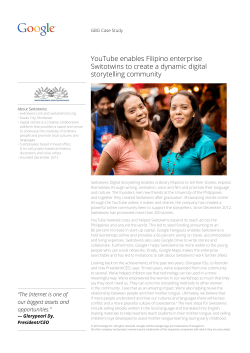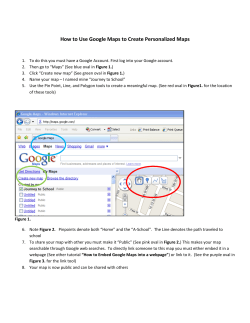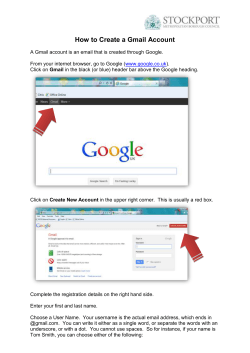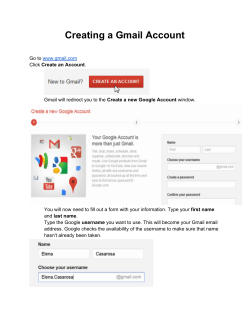
Creative Convergence
Creative Convergence Conducting a systematic review project through cross-institutional, distance collaboration This presentation is licensed CC-BY 4.0 Objective To reflect on a cross-institutional systematic review project: What are effective collaboration methods for geographically dispersed research teams? We compared our experiences to literature on collaborative research: ● ● ● ● ● Benefits Challenges Team Characteristics Success Factors Best Practices Benefits Our Project Systematic Review on: Effective Library Instruction for EBP Health Sciences Education Our Team Experience New Perspectives International Networking SR Experience Build Technical Skills Publication Opportunities SR Project Specific Challenges ● ● ● ● Ambiguity of concepts Duplicate citations Lack of abstracts Varied Educational Interventions ● Copyright questions Team Collaboration Challenges Large, Dispersed Team Diverse knowledge & Experience Geography Methodology Development Ambitious Timeline Work/Life Conflicts Decisions - Maintaining Consistency Lit Review What is being written about effective methods for cross-institutional, distance research team collaboration, including: ● dispersed locations and time zones? ● different institutional resources and policies? Searching the lit After trying various options to get to literature *about* how research teams collaborate effectively, especially across institutions and space: research collaboration cross institutional collaboration collaborative research online collaboration Team Science! “The rapid proliferation of scholarly knowledge and the increasing complexity of social and scientifıc problems have prompted growing investments in team science initiatives.” Team-based research with multiple disciplines may accelerate progress towards resolving complex societal and scientific problems Hall, et al., 2012 Shift in how science is being conducted - teams increasingly dominate in production of highimpact, highly cited science; teams are growing in size, and are increasingly located across university boundaries rather than within them. Borner, et al., 2010 How might Med Libs participate in Team Science? SciTS Why developed Definition Momentum Characteristics of Team Science Lit review Large teams - from a few to 50, to 200, to more! Multiple projects Multiple disciplines Different departments, institutions, and geographic locations Diverse goals - discovery, training, translational/public health, policy Team Large team Diverse knowledge and experience Geography Ambiguity of research focus Methodology discussions Benefits Challenges Factors for success Intrapersonal (internal motivations and individual attitudes) Interpersonal (interactions among team members communication, learning, work jointly to accomplish goals) Physical environment (spatial distribution) Technological (technical infrastructure and support) Organizational (influence of team member’s institution as well as make-up and org of team itself) Political/Societal Stokols, D., Misra, S., Moser, R. P., Hall, K. L., & Taylor, B. K. (2008) Ecology of Team Science Recommended Best Practices: Attitudes Be open and adaptable Be willing to learn and participate Communicate Address and resolve conflicts Persevere through difficulties Additional Team & Lit Review Insights Top 3 Recommendations for Team Research Sponsors Train team leaders Facilitate initial f2f meeting Provide teams with technological support Tools - What we used Communication ● Email ● Online meeting software - …(often audio only) ● Recommendation: Use video options when possible, include asynchronous methods such as Google group, discussion board Record Keeping and Production ● Google Drive o Documents o Spreadsheets ● Wiki - some use at beginning, but set up and use had higher barrier than Google Drive options ● Consider: project management platform Citation Management ● EndNote and EndNote Web ● Recommendation: Consider platforms that allow for comment, annotation, and full text sharing within restricted group Project Planning Example timeline at project level Project Planning Example task-specific timeline Example: 1. 2. 3. 4. 5. 6. 7. Preparing a search strategy for 1 database (LISTA via EBSCOHost) based on the group’s model strategy for PubMed/Medline o 3 hours (mainly due to need to adjust MeSH to appropriate LISTA headings) Conduct 1 database search and post the results for the group o 15 minutes Set up an EndNote Web account and become familiar with using it o 30 minutes Title/Abstract Review of 100 abstracts o 1.5 hours Full Text Review of 10 articles (for inclusion/exclusion) o 1.5 hours Additional time to pull full text / request via ILL: 30 minutes with possible wait time of 1-14 days to receive ILL response Data extraction for 1 article o 30 minutes Critical appraisal for 1 article o 15 minutes Example expectation - title/abstract review time for 500 results: 7.5 hours Tools: Communication Consider Online Education recommendations ● Asynchronous o o Discussion forum Email list - Google group ● Synchronous o Video, audio, chat meeting options Tools: Communication Consider Online Education recommendations ● Stable o o Group project website, wiki, or planning platform Deadlines and goals on front page ● Automated o Shared calendar with reminders Tools: Project Planning Prepare Yourself for Team Science Template of questions to consider in preparation Tools Google ● Sites o Project templates ● Groups - discussion and email ● Drive - documents, spreadsheets, forms, presentations ● Calendar - reminders, list-calendar syncing Tools Team Science Toolkit www.teamsciencetoolkit.cancer.gov Tools Team Science Toolkit Tools Systematic Review Toolbox http://systematicreviewtools.com Tools - Data Translate what you learn to support your users Further questions Possible roles for librarians in support of team science ● ● ● ● ● ● Data management Collaboration methods Researcher networks Knowledge sharing and transfer Open access support SciTS research Image Sources ● Map image created by Alison Ferrell and Genevieve Gore ● Project timeline example created by Genevieve Gore ● All screenshots taken by Ginny Pannabecker using the Mac Grab utility application or Windows Snippy application. ● Additional photo and image sources* o http://pixabay.com/en/road-landscape-clouds-sky-348544/ - public domain image o https://flic.kr/p/dUwB97 - CC-BY photo, Education Experts, AJ Cann o http://pixabay.com/en/swiss-corner-kirchlispitzen-r%C3%A4tikon-57259/ - public domain image o https://flic.kr/p/dxvmRd - CC-BY photo, SAM team celebrates landing, NASA Goddard Space Center o http://pixabay.com/en/wave-circle-monitor-send-globe-376967/ - public domain image o http://pixabay.com/en/biology-research-laboratory-220005/ - public domain image o http://pixabay.com/en/laboratory-scientists-research-385349/ - public domain image References Lit Review Breen, H. (2013, October). Virtual Collaboration in the Online Educational Setting: A Concept Analysis. In Nursing forum (Vol. 48, No. 4, pp. 262-270). Börner, K., Contractor, N., Falk-Krzesinski, H. J., Fiore, S. M., Hall, K. L., Keyton, J., ... & Uzzi, B. (2010). A multi-level systems perspective for the science of team science. Science Translational Medicine, 2(49), 49cm24-49cm24. Hall, K. L., Stokols, D., Stipelman, B. A., Vogel, A. L., Feng, A., Masimore, B., ... & Berrigan, D. (2012). Assessing the value of team science: a study comparing center-and investigator-initiated grants. American journal of preventive medicine, 42(2), 157163. García-Milian, R., Norton, H. F., Auten, B., Davis, V. I., Holmes, K. L., Johnson, M., & Tennant, M. R. (2013). Librarians as Part of Cross-Disciplinary, Multi-institutional Team Projects: Experiences from the VIVO Collaboration. Science & technology libraries, 32(2), 160-175. Stokols, D., Hall, K. L., Taylor, B. K., & Moser, R. P. (2008). The science of team science: overview of the field and introduction to the supplement. American journal of preventive medicine, 35(2), S77-S89. Stokols, D., Misra, S., Moser, R. P., Hall, K. L., & Taylor, B. K. (2008). The ecology of team science: understanding contextual influences on transdisciplinary collaboration. American journal of preventive medicine, 35(2), S96-S115. Vogel, A. L., Hall, K. L., Fiore, S. M., Klein, J. T., Michelle, B. L., Gadlin, H., ... & Falk-Krzesinski, H. J. (2013). The team science toolkit: enhancing research collaboration through online knowledge sharing. American journal of preventive medicine, 45(6), 787. Tools Google Sites http://www.google.com/sites/overview.html NIH - Prepare Yourself for Team Science - Collaborative Agreement Template https://ccrod.cancer.gov/confluence/display/NIHOMBUD/Collaborative+Agreement+Templat e Team Science Toolkit https://www.teamsciencetoolkit.cancer.gov/Public/Home.aspx HUBzero https://hubzero.org/ Systematic Review Toolbox http://systematicreviewtools.com/ LabKey http://www.labkey.com/ REDCap http://www.project-redcap.org/ Recommended Best Practices For institutions / funders / supporting groups ● Plan ahead using templates ● Clear vision of what constitutes success ● Assessment to track project, adjust ● Guage team member readiness toward teams science: openness and adaptability, previous experience with collaborative projects ● Consider combining strangers and known colleagues ● Provide training for leaders and team members ● Provide platform/tools for project management, communication, and discussion Recommended Best Practices For team leaders ● Communicate with open, enthusiastic, inclusive approach ● Set regular meeting times ● Provide opportunities for f2f meetings to build community ● Utilize centralized planning and production platform ● Plan ahead with team using templates ● Designate roles and responsibilities - when changes, communicate to all along with changed expectations ● Encourage open, frequent, explicit communication o Decisions - reinforce group decisions for consistency ● Address conflicts and work through to resolution Recommended Best Practices For individual team members ● Attitudes: openness, adaptability, willingness to devote substantial time to learning and participating, egalitarian values ● Commit time needed ● Active participation in meetings, planning, and tasks ● Keep up with progress and activities ● Communicate openly, with empathy, explicitly, and often ● Willingness to address conflicts and work to resolution Presentation Contact for questions: Virginia Pannabecker, GinnyP@vt.edu Authors: Virginia Pannabecker, Carolyn Dennison, Alison Farrell, Genevieve Gore, Assako Holyoke (SR Team Leader), Viola Machel, Christine Marton, Kelly O’Brien, Stephanie Swanberg, Mindy Thuna
© Copyright 2025













